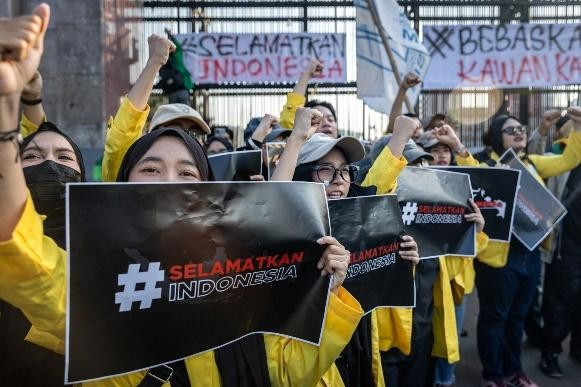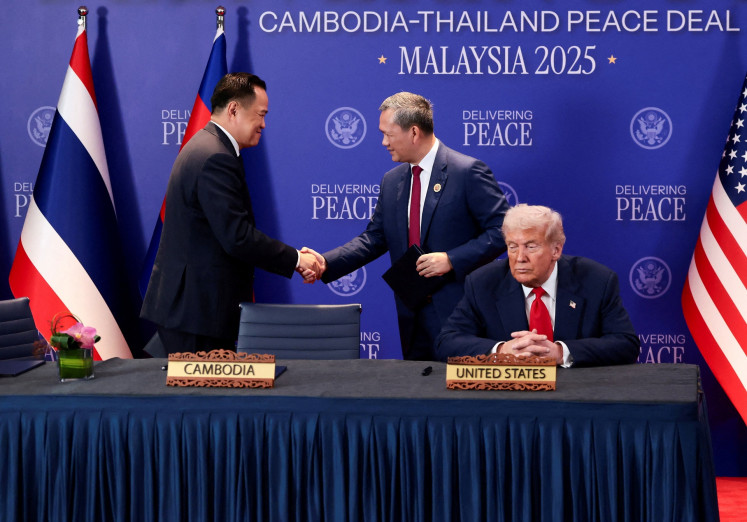Popular Reads
Top Results
Can't find what you're looking for?
View all search resultsPopular Reads
Top Results
Can't find what you're looking for?
View all search resultsInvesting in growth and connectivity in the strategic triangle
The future of our growth triangle is bright, with its strategic position, natural resources, established cooperation modalities, and home to a young and digitally savvy workforce.
Change text size
Gift Premium Articles
to Anyone
Between the Andaman and the South China Seas lies the Strait of Malacca, one of the world’s most significant trade routes.
Serving as the gateway for the economies of both Asia and Europe, approximately 60 percent of the world's trade traverses this waterway. Moreover, it plays a pivotal role in global energy distribution, facilitating the passage of at least 15.5 million barrels per day of crude oil from the Middle East Gulf and West Africa and accounting for a quarter of the world's seaborne oil trade.
Given these facts, the connectivity of the countries along the strait is vital for regional and global trade.
This was the focus last week as Indonesia chaired the 29th Ministerial Meeting of the Indonesia, Malaysia Thailand Growth Triangle (IMT-GT) in Batam, Indonesia’s emerging free trade zone and special economic zone.
This year also marked the 30th anniversary of IMT-GT, a vibrant subregion comprising 94 million people. Much has been achieved over three decades of partnership and cooperation. The growth triangle has a US$538.6 billion current gross domestic product and recorded $727.2 billion in total trade in 2022. Its success is premised on empowering local governments and private sector entrepreneurship to deepen and broaden economic integration.
The IMT-GT economic cooperation framework brings together 10 provinces of Sumatra, Indonesia, eight states in Peninsular Malaysia, and 14 provinces in the southern region of Thailand. Together, we have built six economic corridors and have growing numbers of special economic zones and industrial parks.
We enhanced cooperation on transportation connectivity, trade and investment facilitation, tourism, agriculture and agro-based industry, halal products and services, digital transformation, human resource development and the environment.
IMT-GT has also prioritized 36 physical connectivity projects worth $57 billion.
The future of our growth triangle is bright, with its strategic position, natural resources, established cooperation modalities and home to a young and digitally savvy workforce. Ministers are determined to seize these opportunities, however, we also recognize that new and emerging challenges lay ahead, as such we considered innovative and creative solutions to futureproof our shared prosperity.
After decades of peace and stability, we are facing headwinds, from rising geopolitical uncertainty, structural changes rewiring economies, as well as shifting patterns of trade and supply chains. Ministers discussed how to improve the subregion’s economic resilience as well as embracing new drivers of economic growth.
Our goal must be to remain connected and internationally competitive and ensure practical and concrete cooperation that delivers tangible benefits that are shared broadly throughout the subregion and its people.
We resolved to revitalize cooperation by working hand in hand with subnational and local governments, businesses and other relevant stakeholders. Stronger private sector engagement is vital, including micro, small and medium enterprises (MSMEs), to drive local development and to strengthen and diversify regional value chains.
Cooperation should involve local governments from the beginning to ensure integrated planning and implementation for better impact. Ministers also recognized the importance of on-the-ground facilitation, particularly stronger feedback loops to ensure timely decision-making to stay on track in a fast-moving context.
Removing barriers to connectivity remains a top priority for IMT-GT, especially through developing infrastructure, digital and payment connectivity, facilitating trade, and by enhancing regulatory and planning cooperation.
Ministers highlighted the priority of mobilizing adequate resources from the private sector and development partners to realize seamless connectivity in our subregion's region and encouraged external support to reinforce the IMT-GT agenda for growth and resilience.
We are determined to deliver economic opportunities in high-potential sectors toward subregional development and stronger regional value chains. IMT-GT supplies almost 60 percent of the world’s natural rubber and 88 percent of the world’s palm oil. So, we are focusing on key growth sectors through initiatives such as IMT-GT Rubber Cities, collaborating among palm oil-producing countries, and improving rice production to strengthen food security.
The growth triangle must also unleash the potential of emerging growth areas such as the digital, green, circular and blue economies. A stronger focus on decarbonization and sustainable growth is reflected through enhancing cooperation on green cities and sustainable urban development, among other new initiatives.
Lastly, we are positioning our growth triangle to truly serve as a building block for the broader ASEAN vision and beyond. Connectivity in the subregion will contribute to the vision of the Master Plan on ASEAN Connectivity. The benefits go both ways, with IMT-GT also gaining from regional initiatives, such as the ASEAN Industrial Project-Based Initiative, ASEAN Smart Cities Network, ASEAN QR payment interconnectivity and the recently launched development of the ASEAN Digital Economy Framework Agreement.
With bold vision and by embracing change and innovation, we have a once-in-a-lifetime opportunity to revitalize growth and resilience along the Malacca Strait. Unleashing this potential requires political commitment, effective and inclusive stakeholder engagement, and resourcing.
***
The writer is the coordinating minister for economic affairs and signing minister of IMT-GT.











